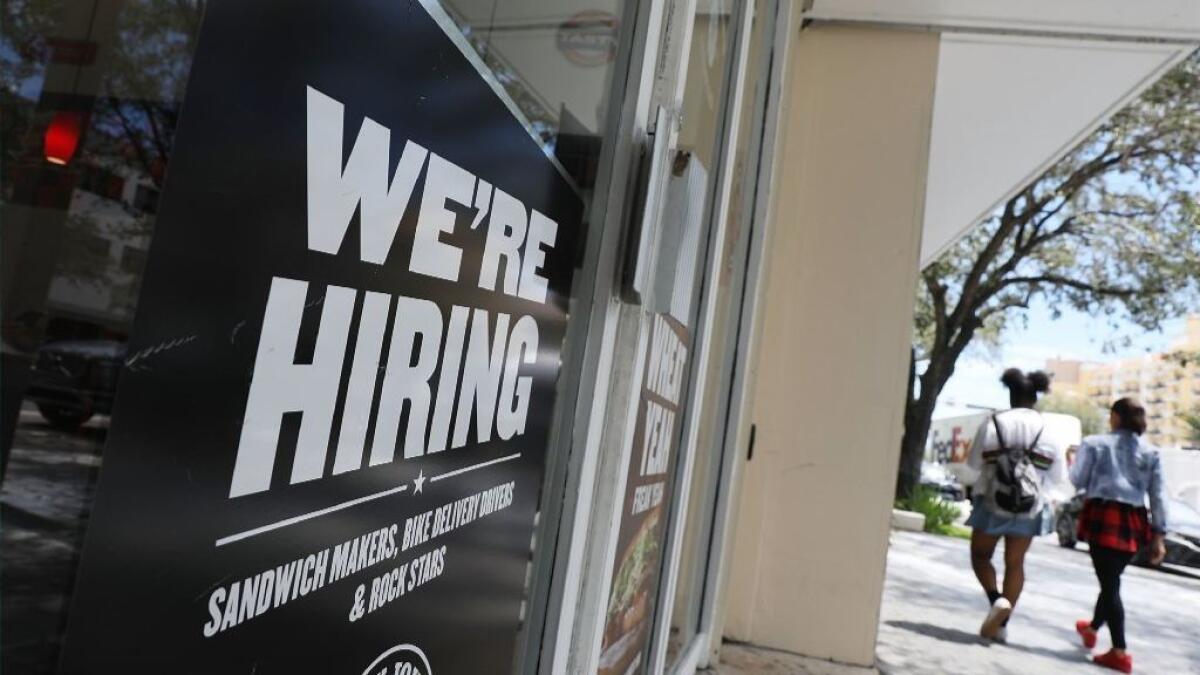Household incomes hit new high, but rate of health coverage flattens, Census Bureau says

- Share via
Reporting from Washington — With unemployment steadily declining and more people working full time in year-round jobs, household incomes in the United States rose moderately last year, and the nation’s poverty rate fell to the lowest point in more than a decade, according to new federal government data.
But in another important measure of economic well-being, the share of Americans without medical insurance remained unchanged in 2017, ending a three-year trend of improving health coverage that was largely the result of Obamacare.
The Census Bureau found that 8.8% of the U.S. population went without medical insurance for all of 2017, the same rate as in 2016. By contrast, in 2013, before the Affordable Care Act took full effect, 13.3% were uninsured.
“We should have seen further progress, but we didn’t,” said Judy Solomon, a health policy expert at the Center on Budget and Policy Priorities. She attributed the stall in health-coverage improvements to cuts in outreach programs that aim to tell consumers about their healthcare options and other actions by the Trump administration to undo parts of Obamacare.
On the whole, the Census Bureau’s annual report Wednesday on income, poverty and health insurance coverage mostly showed continued but moderating gains in 2017 — 10 years after the start of the Great Recession caused American incomes to begin to tumble.
The deep downturn officially ended in June 2009, but the nation’s median income — the midpoint where half makes more and half less — didn’t start rising again until 2014. Last year, it reached $61,400.
On an inflation-adjusted basis, that was up 1.8% from 2016, compared with growth of more than 3% and 5% in the prior two years.
The sustained growth nonetheless lifted the median income to the highest point on record although census officials said that figures from some previous years weren’t totally comparable.
The slow wage increase partly reflects the advanced stage of the economic expansion, which is in its 10th year. It also reflects shifting demographics.
“We’ve been successful pulling people into the labor market, but baby boomers are leaving in large numbers and that’s going to counteract the increases,” said Harry Holzer, a public policy professor at Georgetown University.
As the jobless rate has fallen to below 4%, the labor market has tightened, and the latest monthly jobs report for August signaled a possible quickening of wage increases. The White House has argued that real incomes are growing faster than government statistics would suggest, but economists said the key to boosting earnings is increasing productivity — which has been lackluster the last few years.
Douglas Holtz-Eakin, an economist and president of the conservative-leaning American Action Forum, called the 1.8% real income growth “decent.”
U.S. economic growth has accelerated this year under Trump, thanks in part to the big GOP tax cuts, and Holtz-Eakin said that by this time next year, the nation could be looking at faster income gains.
But the key will be what happens with productivity. “In the long run, that’s everything,” he said.
Last year median incomes rose fastest among Latino and white households; and in the West and Midwest. Among workers, women saw no gain in median incomes last year.
Young adults badly lagged behind older households in earnings. And that probably is a major factor in another less-encouraging finding in Wednesday’s report: As of March this year, the share of adults 25 to 34 years old living with their parents was 16.8%, up from 16.1% a year earlier.
Although census officials said the change was statistically insignificant, Richard Fry, a senior economist at Pew Research Center, said this much can be said: “You just don’t see in the data much vigor in young adults getting out of their parents’ basements and starting households.” That doesn’t bode well for the housing economy, he said.
Overall, the share of people in the country living in poverty dropped to 12.3%, down from 12.7% in 2016. Still, that means almost 40 million people in America lived in poverty last year, including 12.8 million under the age of 18. The poverty rate was as low as 11.3% in 2000.
By the Census Bureau’s definition, children and adults are considered poor if they live in households with income below the poverty line, which in 2017 was $24,858 for a family of four.
Follow me at @dleelatimes
UPDATES:
11:55 a.m.: This article was updated with additional data and reaction from economists.
This article was originally published at 8:30 a.m.
More to Read
Inside the business of entertainment
The Wide Shot brings you news, analysis and insights on everything from streaming wars to production — and what it all means for the future.
You may occasionally receive promotional content from the Los Angeles Times.











